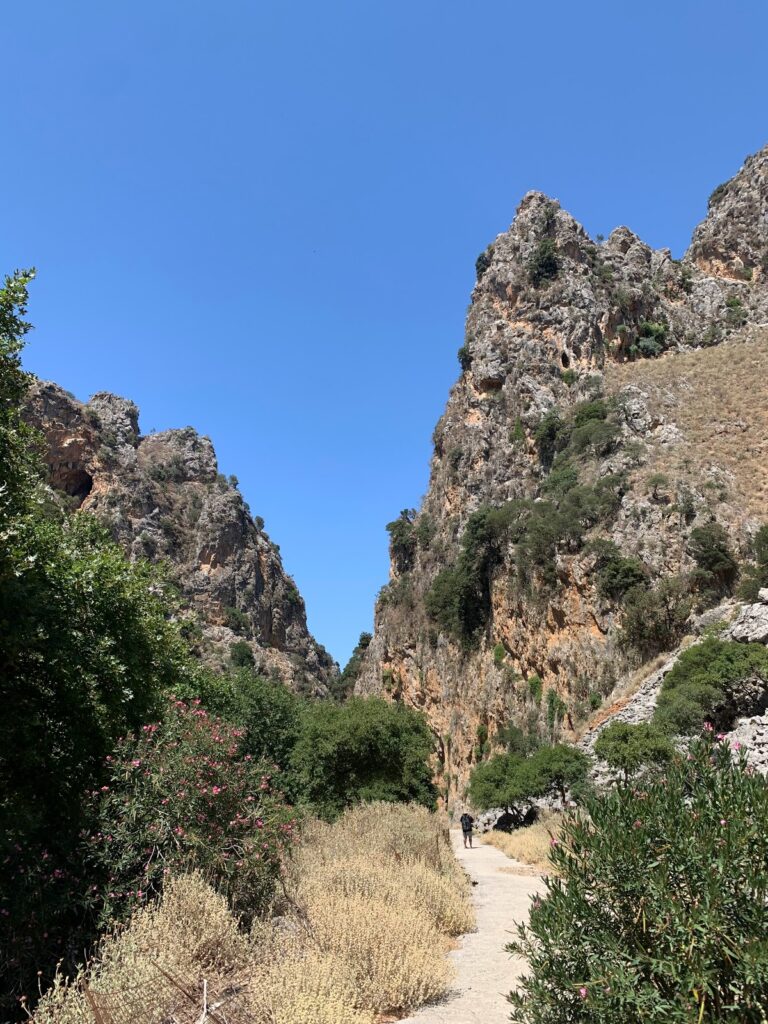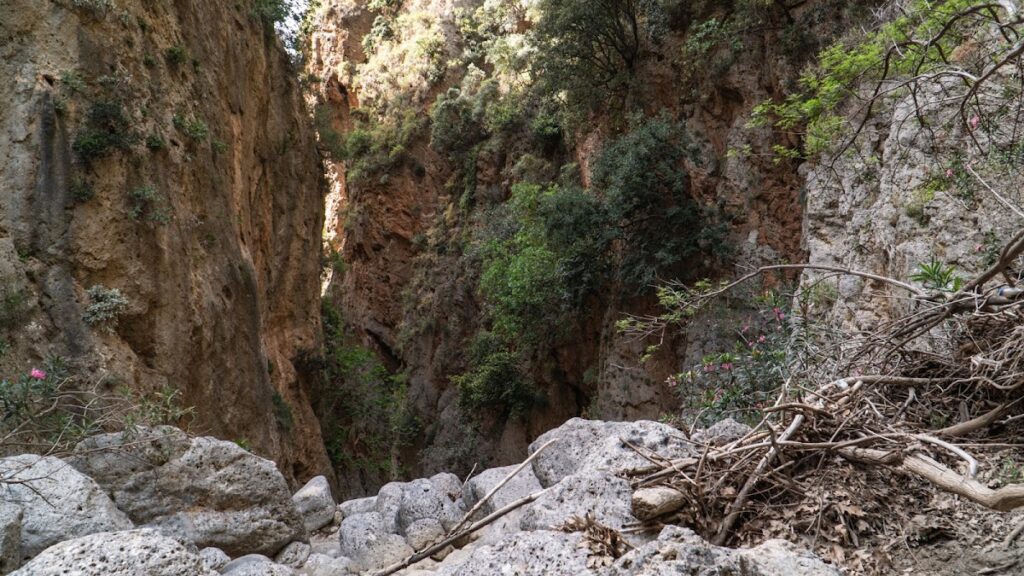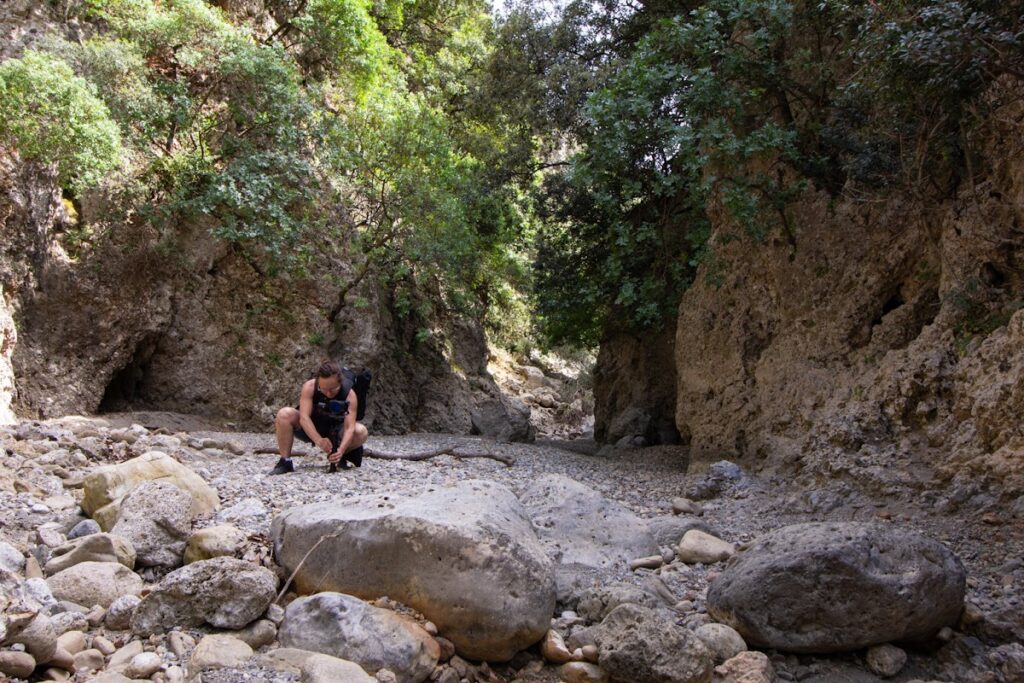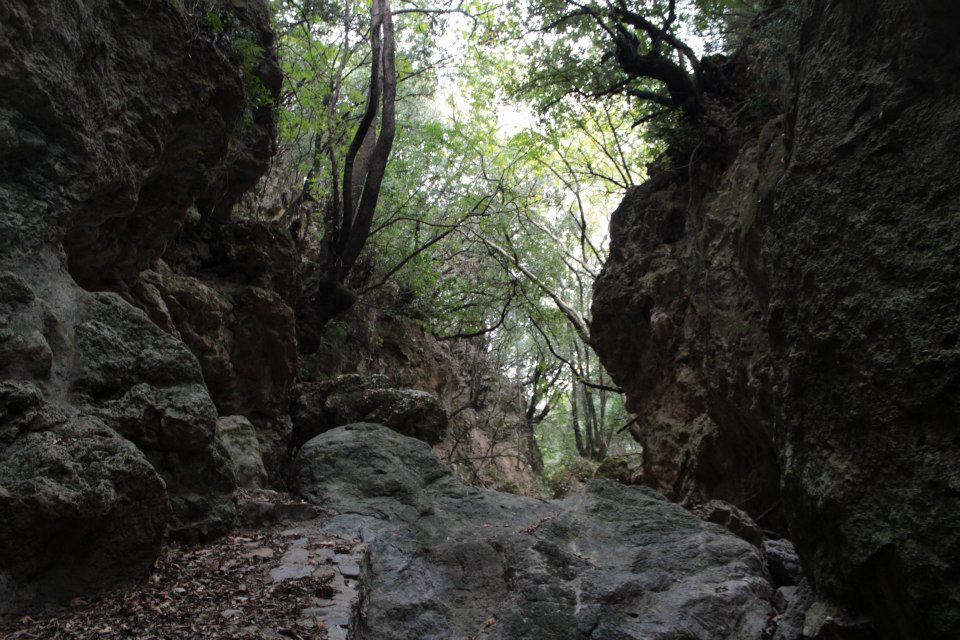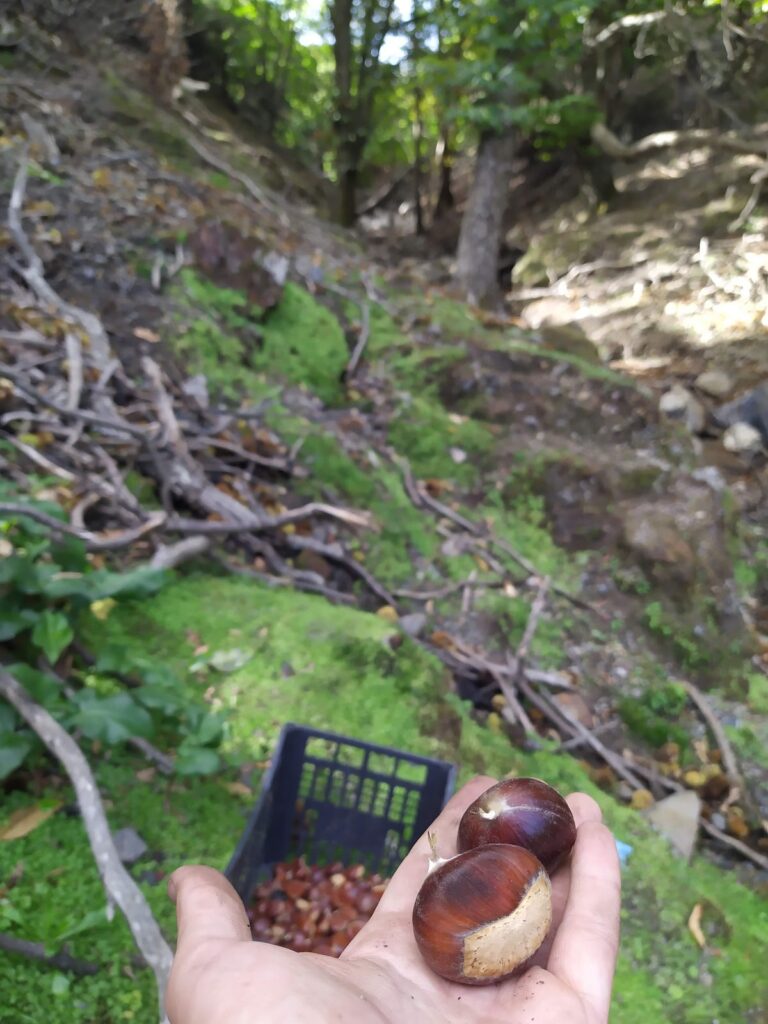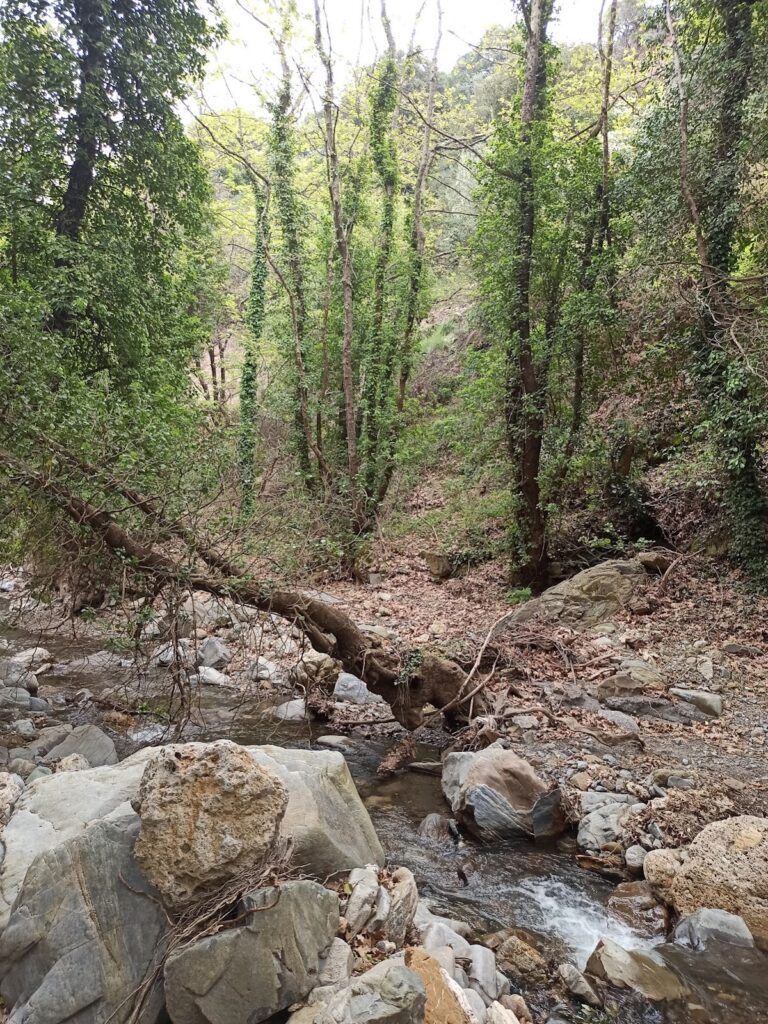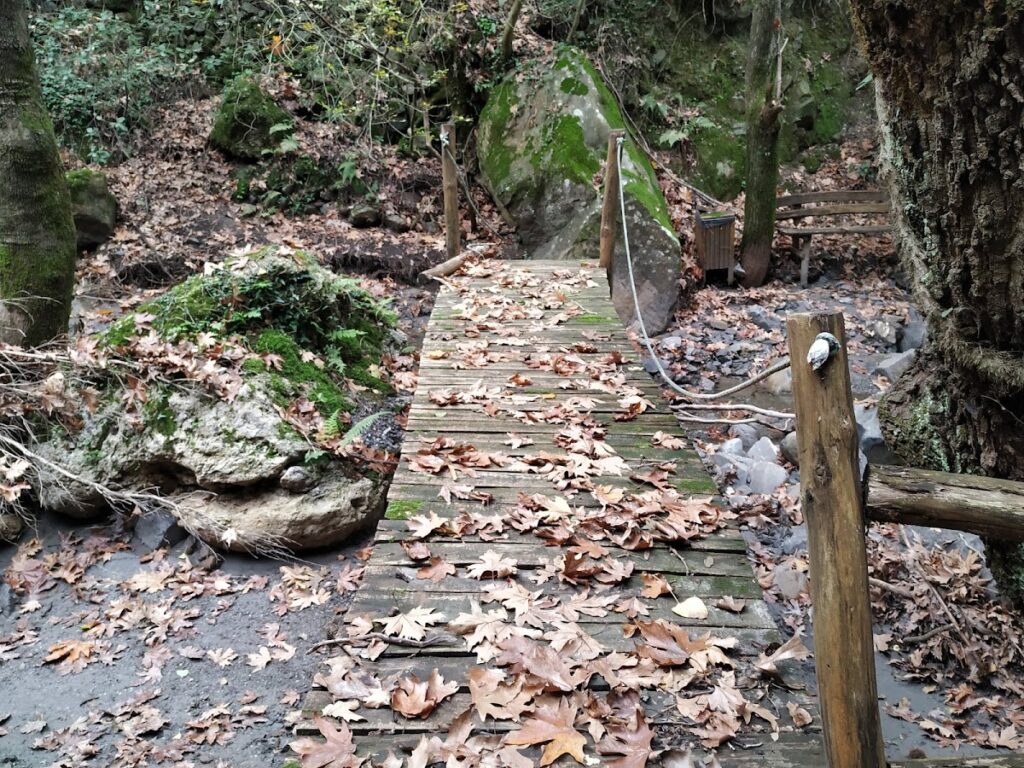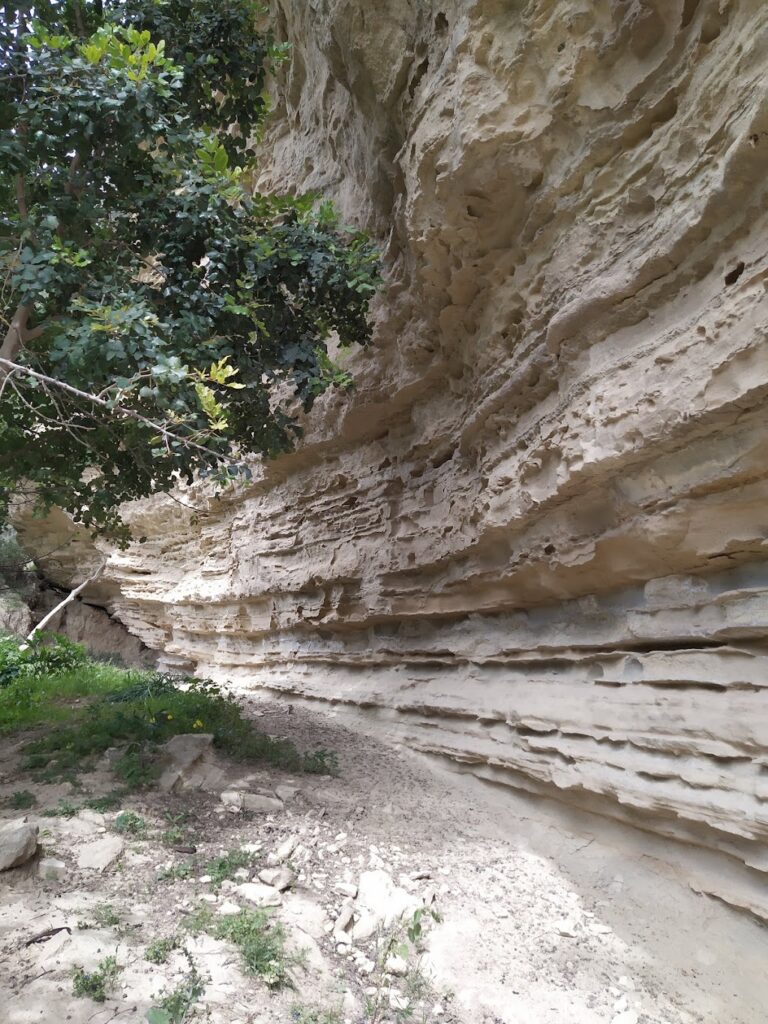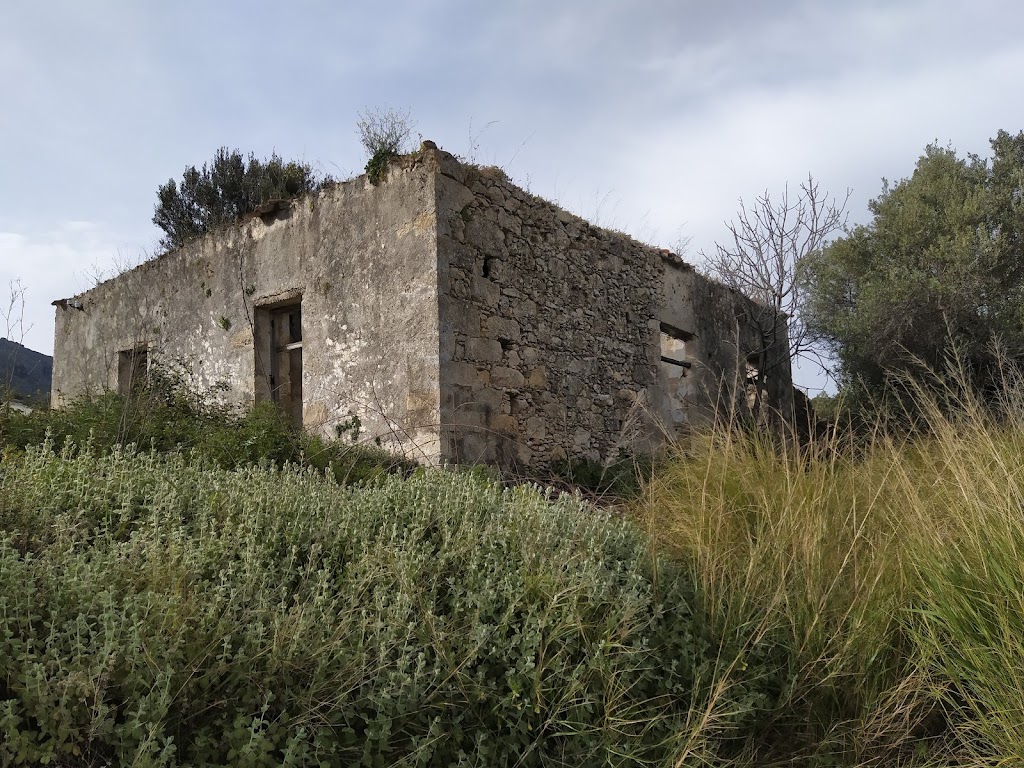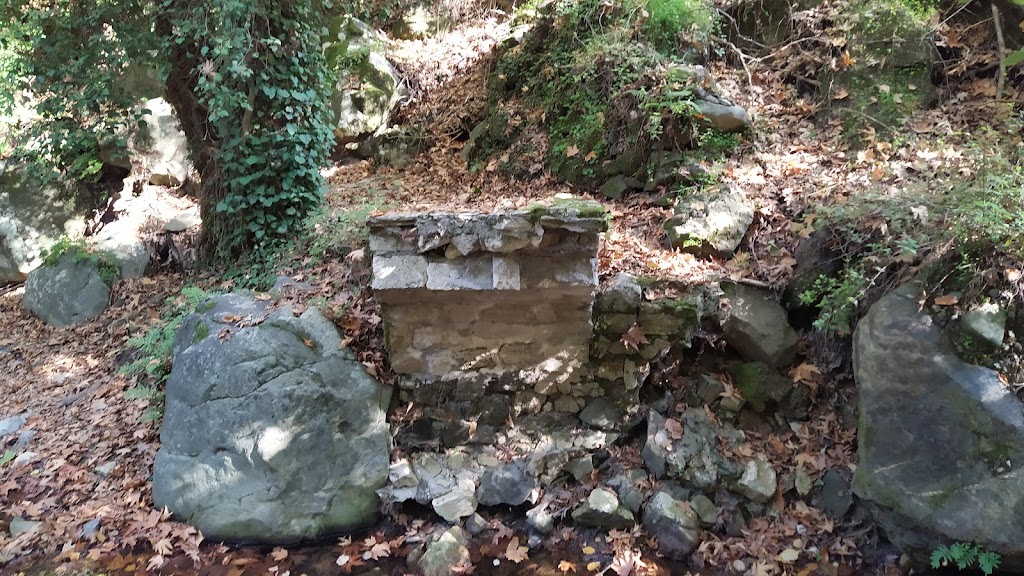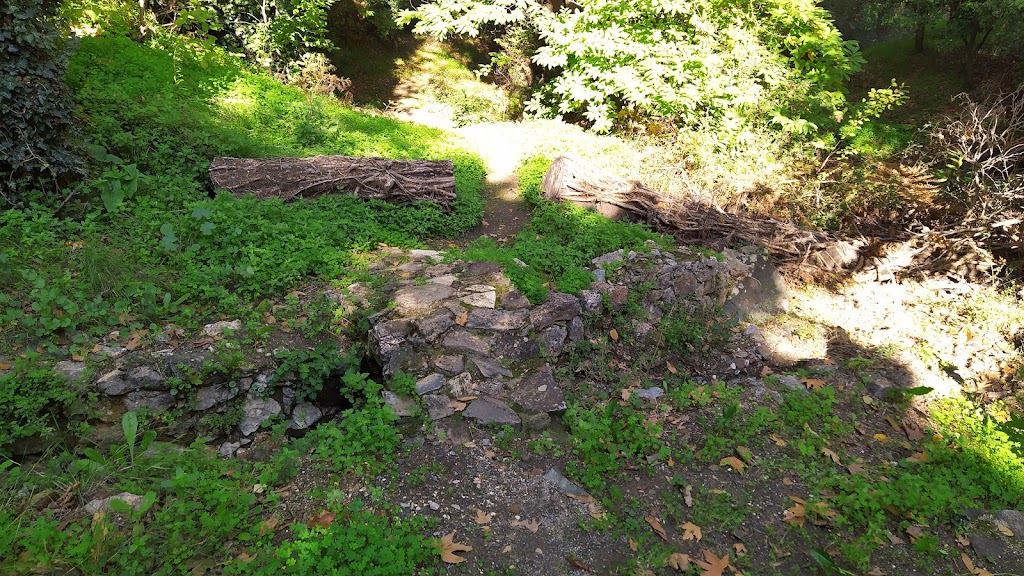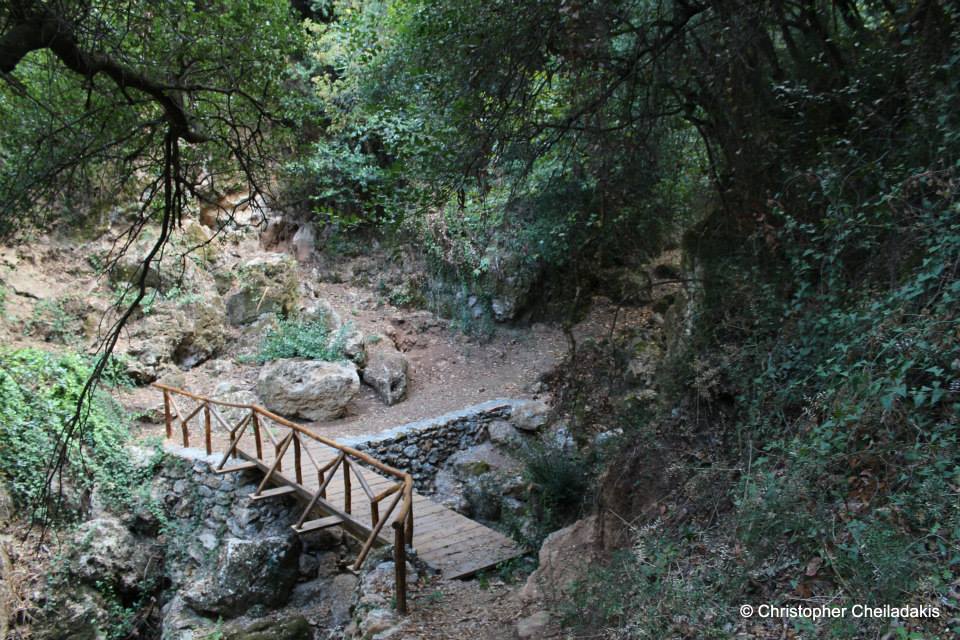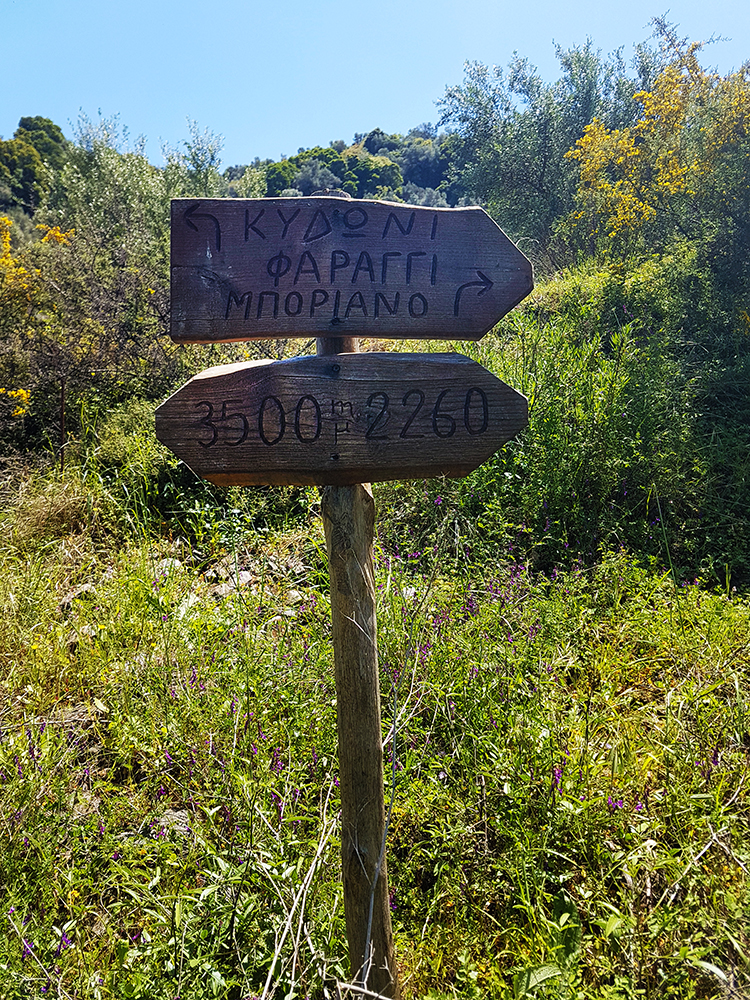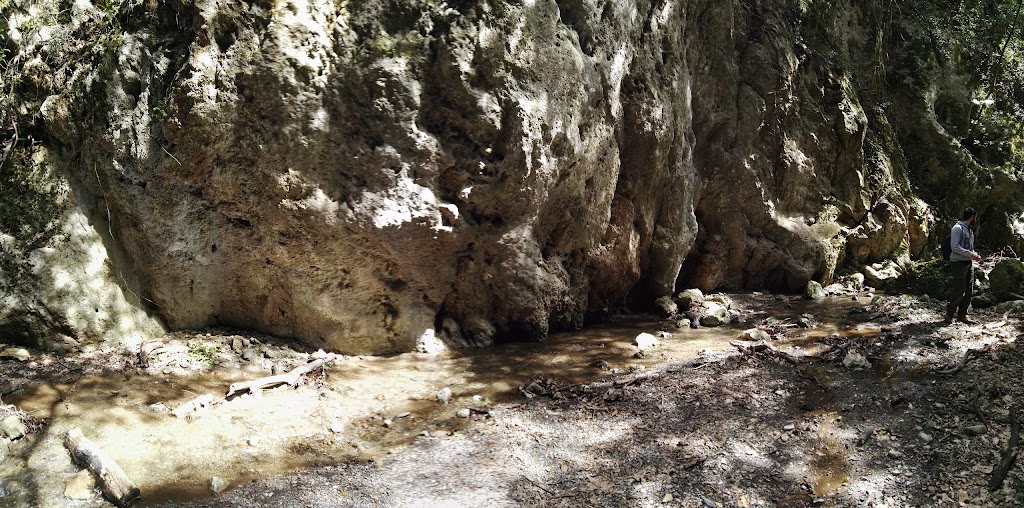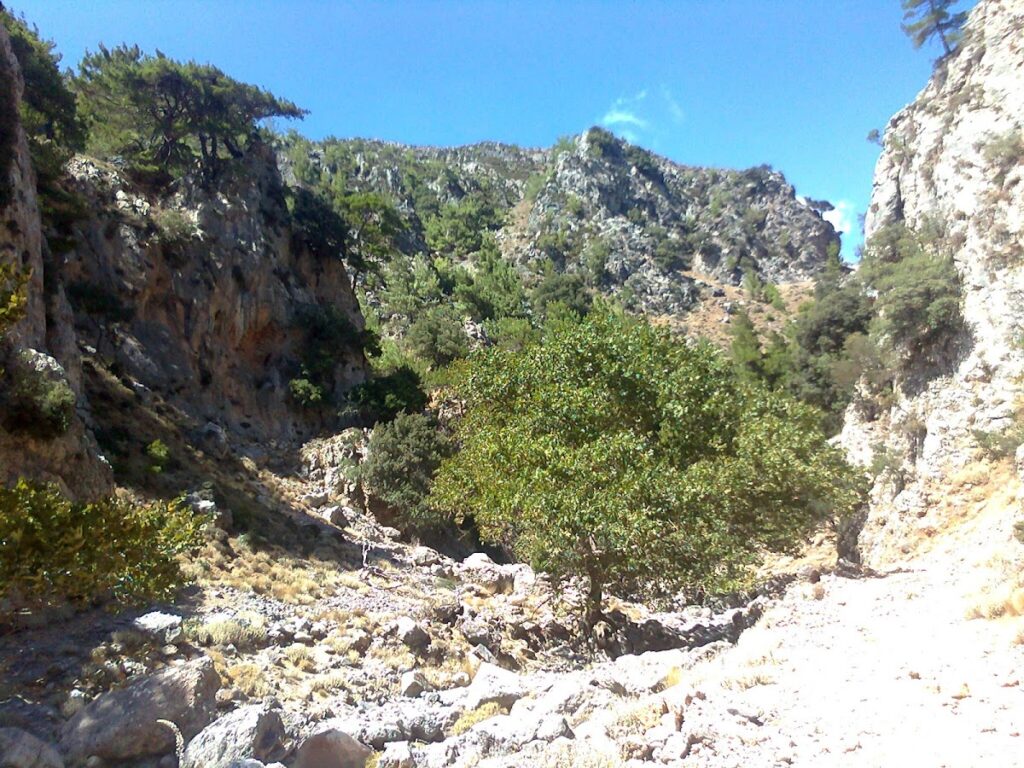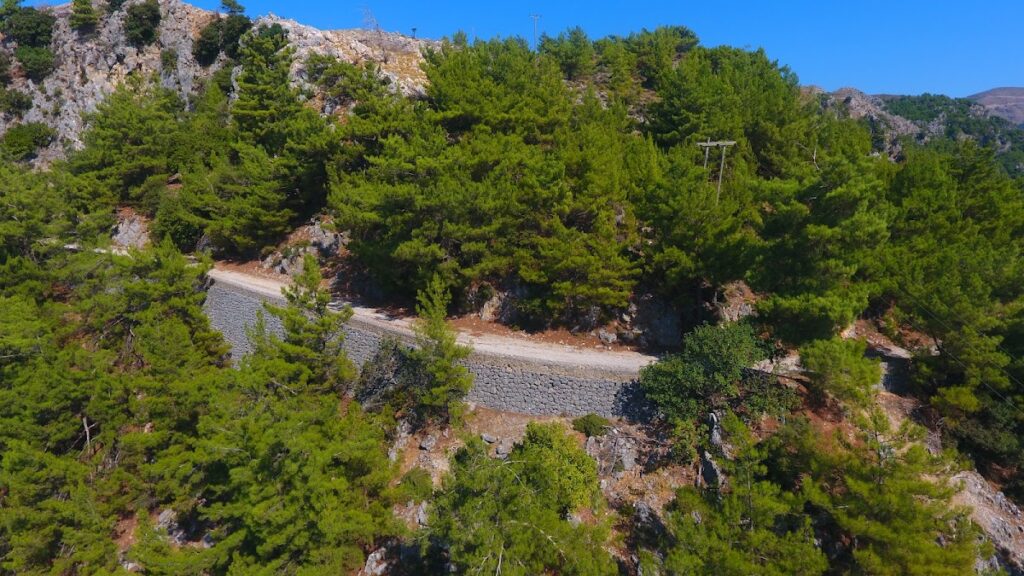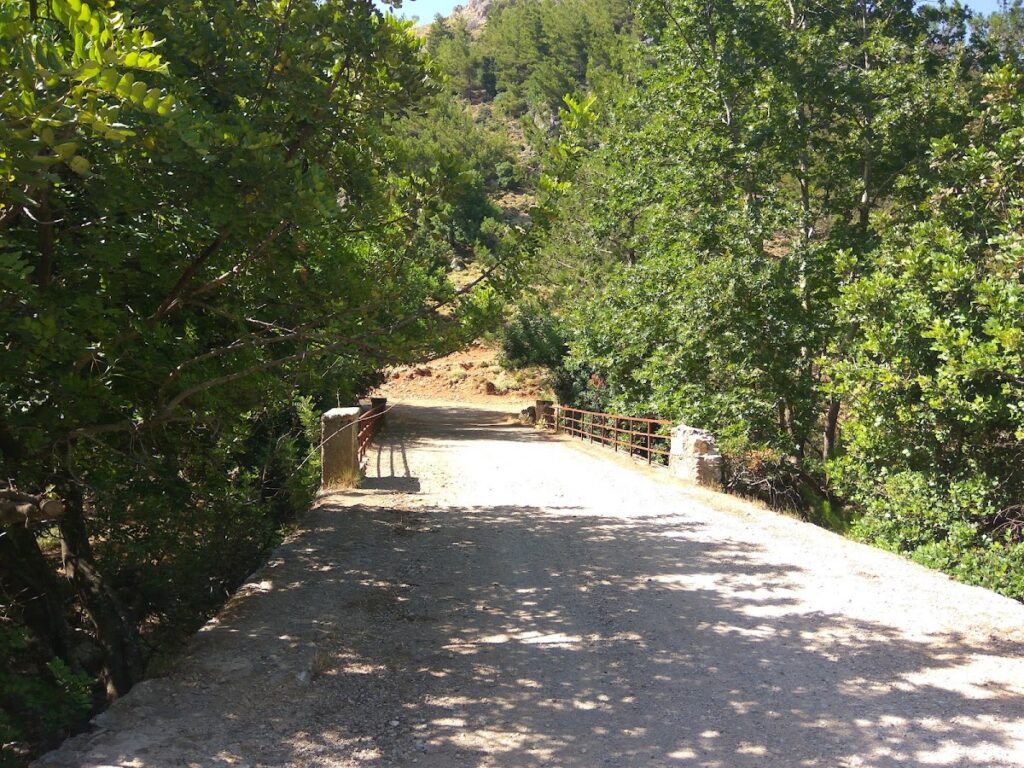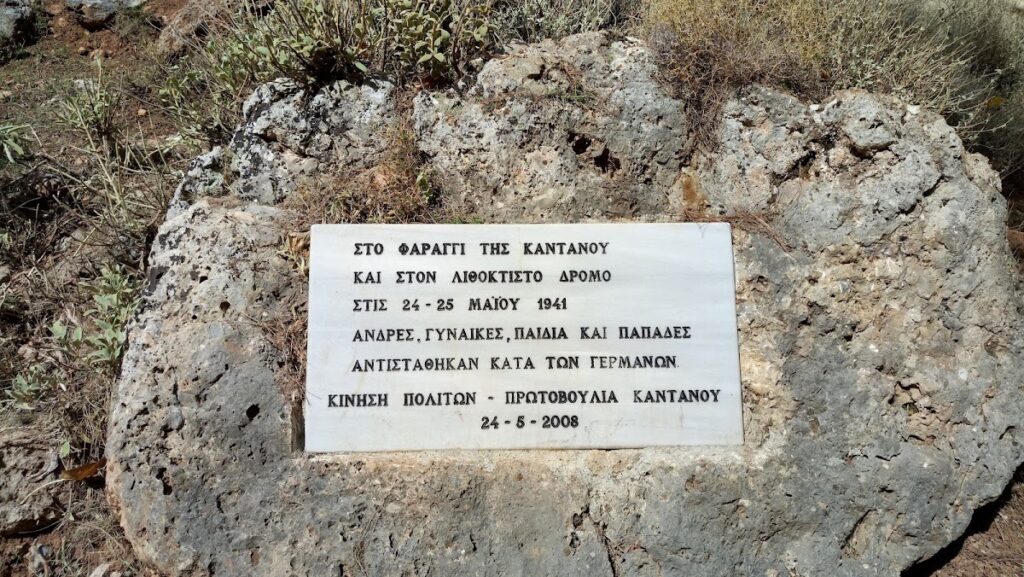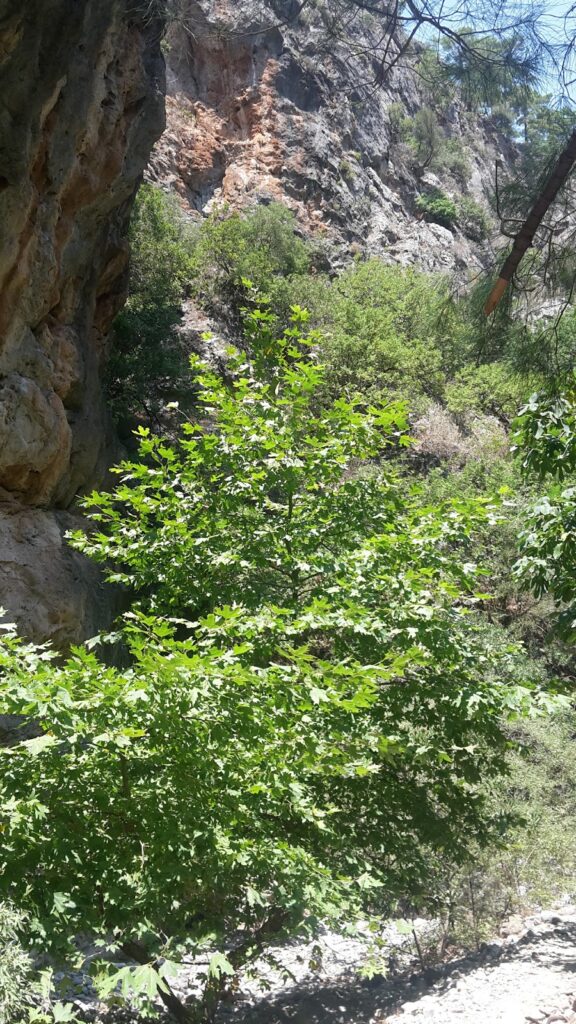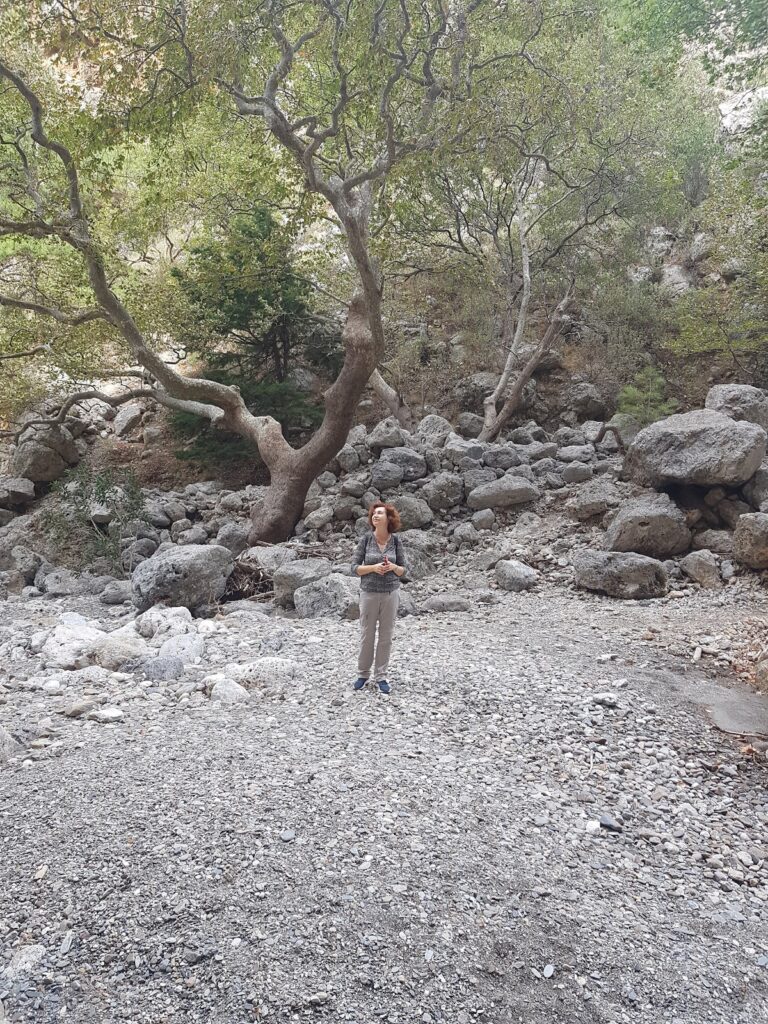Gorges to hike and walk near Pigí, in Chania region
List of Gorges near Pigí
- 6.6 km
- Roka Gorge
- 2 km
- 2 h
- Hiking
The Rocca, Roka, Rocka, or Rokka Gorge, situated 32km west of Chania in the Kolymbari region, stretches for 2km from the village of Deliana to the village of Roka. The settlement features Trouli hill, which is home to the remnants of a Byzantine fortress.
Despite the ease of hiking through the gorge (typically a 2-hour trek), it can be challenging to traverse without getting wet during periods of water flow in the narrower sections. The gorge is adorned with numerous plane trees that provide a cool respite from the sun. The gorge’s vertical sides are incredibly tall and impressive at certain points. The main path follows the dry riverbed during the summer.
Upon exiting Roka gorge, you’ll encounter the Mesonisi settlement. Following a dirt road will lead you to Roka village and Trouli hill. You can climb up to the castle ruins for a breathtaking view of the surrounding areas, or unwind in the local coffee shop.
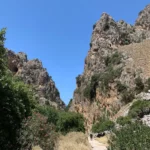
- 7.2 km
- Trahinos Gorge
- 3 km
- 1 h
- Hiking
Located about 35km southwest of Chania city, on the northern slopes of Mount Apopigadi, Palea Roumata is a verdant area. This region is made up of 13 neighborhoods, all part of the same village (Palea Roumata), spread across the slopes. Near the small settlement of Lidiana, the Vavouledo and Trachinos canyons converge, providing an ideal circular route with water until late spring.
The Trahinos Gorge, starting near the Trahinos hamlet, is fairly short but stands as one of Crete’s greenest gorges. Its walls are so narrow that they’re almost unnoticeable from above. The gorge is filled with dense vegetation, often casting shadows over the riverbed. Similar to Vavouledo, the Trahinos Gorge also features a hiking trail.
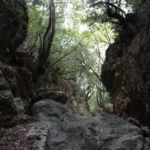
- 7.3 km
- Vavouledo Gorge
- 3 km
- 1 h
- Hiking
The Vavouledo canyon begins approximately 1km east of Hamalevri village, where the Hortes stream flows. A path follows the length of the canyon. Close to Lidiana village, the canyon merges with the Trahinos Gorge, and the combined river continues to the “cosmopolitan” district of Palea Roumata, Arhontika. Here, you’ll find taverns where you can enjoy a meal.
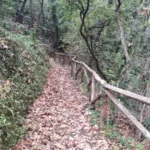
- 7.4 km
- Mesavlia - Deliana Gorge
- 5 km
- 1 h
- Hiking
The Deliana – Mesavlia Gorge, a point of contention between the villages of Mesavlia and Deliana, is situated 37km to the west of Chania. This disagreement is even evident in the area’s signage. The gorge begins in Mesavlia and stretches 5km to Deliana. A dirt road that runs alongside the riverbed makes the walk quite straightforward, taking approximately an hour. Originating from Mount Anavos, the river flows through the Mesavlia – Deliana Gorge, then the Roka Gorge, before finally reaching Nopigia beach.
The gorge is renowned for its lush vegetation, which is most vibrant in spring when water is plentiful. Not far from Mesavlia, you’ll find the cavernous chapel of Saint Paraskevi (Agia Paraskevi), which hosts an annual feast. Closer to Deliana, you’ll come across the chapel of Saint Photios (Agios Fotios).
The quickest way to reach the gorge from Chania is via Deliana, while the fastest route from Paleochora is through Mesavlia. From Deliana, you can hike (uphill) to Mesavlia and back, unless you’ve arranged for a pick-up from Mesavlia (2 hours round trip). Deliana and the nearby village of Panethimos offer several quaint, traditional taverns. Also worth a visit is the ruined monastery of Theotokos in the neighbouring village of Gra Kera.

- 8.9 km
- Chalase Gorge
- 4 km
- 4 h
- Hiking
The Gorge Chalase, also known as Porofarago, begins close to the Sassalos village and concludes just before reaching the Makronas village, after a four-hour journey through lush vegetation. The gorge is fed by two primary streams that converge south of Sassalos; the Mylonofarago ravine that originates from the Mylones village, and the Kalogirou stream.
Navigating through the gorge can be quite challenging due to a significant landslide (referred to as ‘chalase’ in the Cretan dialect) at a certain point, and the absence of a well-defined path. Near Malathyros, approximately halfway through the route, the trail transitions into a dirt road that follows the riverbed all the way to Makronas. Just before reaching Makronas, we come across a historical site where, on August 28, 1944, German forces executed 62 civilian men from Malathyros as retribution for the activities of local guerrilla groups. The German atrocities committed during this time have yet to be brought to justice.
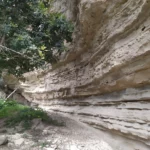
- 10.4 km
- Askidia Gorge
- 2.5 km
- 2 h
- Hiking
The Prasses or Askidia canyon is nestled within the forested area of the White Mountains. The exit of this canyon is situated close to the Askidia village (at an elevation of 480m), which is a section of the Prasses village, hence the dual names. To find the beginning of the canyon, you need to drive on the road from Chania to Sougia, then take a turn at Petras Seli intersection that leads to Omalos Plateau. After approximately 1.5km past the turnoff to Omalos, you will come across a dirt road and footpath that lead to the Platanos area. This region is captivating with its ferns, plane trees, and water springs. It is also the starting point of the lush Prasses canyon, a journey that takes roughly 2 hours.
The gorge boasts striking vertical walls and is surrounded by a thick pine forest (the northernmost in the Chania prefecture). This, combined with the river bed’s deciduous trees (such as maples and sycamores), creates a stunning landscape, particularly in the fall. The canyon is perfect for leisurely hikes along its riverbed, taking photos, and bird watching. Additionally, there are 2-3 small caves along the walls. Upon exiting the gorge, you will encounter the tiny hamlet of Askidia, concealed within a thick chestnut forest. If you don’t have a car, an additional half-hour walk will take you to the picturesque Prasses village.
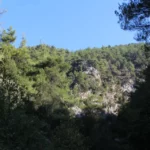
- 11.1 km
- Boriana Gorge
- 2 km
- 1 h
- Hiking
The verdant Boriano canyon, more commonly referred to as Karanou Gorge, begins in the Boriana neighborhood of Karanou village and extends for 1800 meters until it merges with the Mavropiliotis River via an attractively laid out path. The trail features a dilapidated watermill, caves, and the entrances to the old iron ore quarries (locally referred to as the Averof quarries), along with a charcoal furnace and tunnels. The gorge runs parallel to the Kydoni Gorge, and it’s common for hikers to explore both gorges simultaneously.
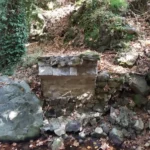
- 11.4 km
- Topolia Gorge
- 3 km
- 1.5 h
- Hiking
The gorge of Topolia (Topoliano) is located in west Crete and it runs along the road leading to Elafonissi via Elos. The canyon actually starts near the village Strovles at an altitude of 450m, and exits near the village Topolia, at an altitude of 150m. However, the narrowest and most impressive hiking part of the gorge is located between Katsomatados and Topolia, where the side rocks are very high and steep. The canyon is crossed by the River Tyflos, which originates from Mount Dikeos. At the beginning of the narrow part, it is worth visiting the Cave of Agia Sofia, located just above the main road.
The canyon and the wider area host rare and endemic plants of Crete, while the Cave of St. Sophia houses a species of cave spider that lives only there (Pholcus creticus). According to local traditions, Topolia Gorge hosted fairies and the Minoan goddess Vritomartis. Here, the legendary Talos used to stop and enjoy the divine music of the fairies. When Talos arrived at the place, rested inside a big cave, drank water and fell asleep. Then, the fairies and elves of the river arrived, singing and dancing.

- 11.9 km
- Kydoni Gorge
- 2 km
- 1 h
- Hiking
In the mountainous region of Kydonia near Chania, nestled at the base of the White Mountains, you’ll find the picturesque Kydoni gorge. Named after the area, not the Greek word for “quince” which is also kydoni, this gorge is one of the most verdant in Crete, boasting lush vegetation with trees towering over twenty meters high. The journey begins in the village of Karanou, starting at the site of an ancient fountain. A downhill path takes you through a breathtaking centuries-old olive grove, past the church of Saint Demetrius (Agios Dimitrios) with its remnants of old frescoes, and finally to the stream bed. The greenery is abundant throughout the gorge, with sunlight only filtering through in a few places, making it a perfect spot for a cool walk on a hot, sunny day.
The trail that traverses the gorge is one of the most well-marked in Crete, with signs posted every 500 meters indicating the distance. The entire route is 2 km long, ending where the Kydoni stream meets the Platanias river tributary, Mavropiliotis, in the Mavra Pila area. The name Mavra Pila translates to “dark muddy soil” in the Cretan dialect, a fitting description for the blackish soil that turns into black mud when wet.
The trail continues from the end of the Kydoni gorge into the Boriano gorge, which runs parallel to Kydoni and originates from the Boriana neighborhood in Karanou. The Kydoni stream is typically dry throughout the year, only filling with water during the heavy rains of winter. Along the route, there are 2-3 small waterfalls, with the tallest one crossed by a charming wooden bridge that leads to a rock shelter adorned with small stalactites. The descent through Kydoni takes about an hour of hiking. Towards the bottom of the gorge, you’ll find two old trails leading to the nearby settlement of Skordalou.

- 12.6 km
- Kandanos Gorge
- 3 km
- 1 h
- Hiking
The Kandanos Gorge is a site of remarkable natural beauty and historical significance, currently threatened by the operations of a large quarry. This gorge was the battlefield for the first armed conflict between locals and governmental forces during World War II. On May 24, 1941, Kandanos residents took up arms against German forces advancing towards their town, a day after the Battle of Floria, where all but one German soldier were killed. In retaliation, the Germans decimated Kandanos and its neighboring villages, executing numerous civilians. To this day, justice for the German war crimes committed in Kandanos and Floria, along with other martyred Cretan villages, remains elusive.
In addition to its historical value, the gorge is teeming with cypress trees and lush vegetation. It’s also traversed by a beautiful stone road leading to Chania, built by locals in the late 1920s. This road stands as a fine example of preindustrial construction.
The upper portion of the Gorge is known as Spina Gorge, named after a nearby village. The lower section, which begins where the gorge intersects the stone road near the Church of Agios Irineos and ends at Anavos, is referred to as Kandanos Gorge. Despite the different names, they are part of the same ravine.
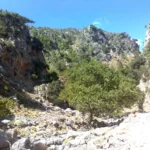
- 14.2 km
- Agia Irini Gorge - Chania
- 7.5 km
- 3 h
- E4 trail
Situated on the western flank of the White Mountains in the Selino province, the Agia Irini gorge owes its name to the nearby village of Agia Irini (Saint Irene), a mere 46 km from Chania.
The trail of Agia Irini Gorge commences just below the Agia Irini village and concludes at the Oasis Taverna. The track, which descends approximately 500 meters, extends for 7.5 km and requires nearly three hours to navigate. It is a well-preserved and predominantly shaded path, embellished with pine trees, plane trees, and oleander bushes.
The journey from the exit of the gorge to the village of Sougia covers about 5 km along a lightly used road with scarce shade. On sweltering days, arranging transportation to Sougia is recommended. The gorge, which is open all year round, is graced with a small river, but certain sections may become inaccessible or dangerous after heavy rain. From April to October, during the tourist season, a nominal fee is collected at the entrance (or exit for those hiking uphill) of the gorge. This fee aids in maintaining the path, collecting trash, and general upkeep to ensure a pleasant experience for all visitors.
The gorge forms part of the European footpath E4. Its southern entrance is positioned 5 kilometers north of Sougia. It is included in the NATURA 2000 protected areas and has been declared a wildlife reserve by the Ministry of Agriculture. The gorge is home to the endangered Cretan ibex, agrimi, and boasts a variety of microenvironments and habitats for an array of wildlife species. The diverse flora, including trees (cypress, pine, maple, plane, oak, holm oak), shrubs, brushwoods, and fine herbs such as dittany, is of significant importance.
The gorge holds immense significance, not only for its rich biodiversity and aesthetic appeal but also for its historical and cultural significance. At the “Polla Spitakia” area within the gorge, rebels found refuge from the Ottomans. This is where the “Fygou” path begins, which served as an escape route from the gorge to the Omalos plateau. The area houses the Byzantine Church of Christ (1358 AD) and the dilapidated church of Saint George (1460 AD). The gorge, second in popularity to Samaria in the Chania prefecture, remains open for a longer duration.
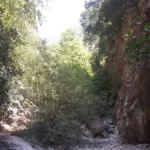
- 14.7 km
- Fygou Gorge
- 3 km
- 1 h
- Hiking
Fygou Gorge, a small yet stunning sub-gorge of the renowned Agia Irini Gorge, is situated near Sougia. This narrow canyon played a significant role in history, serving as an escape route for local rebels to the Sfakia mountains during various revolutions, hence its name ‘Fygou’, meaning escape.
In present times, many trekkers embarking on the Agia Irini Gorge trail, the second most popular gorge in Crete after Samaria, choose to commence their journey from Fygou Gorge. After approximately an hour of walking, they meet the Agia Irini Gorge.
A beautiful path winds through Fygou, weaving between a picturesque cypress and pine grove. An abandoned settlement and a Forest Service outpost can be found at the location known as Polla Spitakia. Near the point where Fygou Gorge meets the Agia Irini Gorge, the historic Hirotrypa cave is located. This site marks a tragic event from 1822 when two local hermits were murdered by the Ottomans.
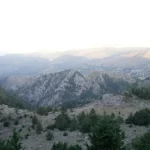
No results available
ResetGorges in other nearby areas
No results available
Reset